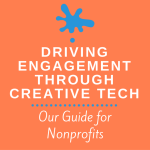Nonprofit organizations are approaching a crisis of engagement. Supporters are being asked (repeatedly) for money, or to add their names to petitions–many of which have highly questionable impact. Petitions with list-building motives serve a purpose for the nonprofit, but they do little to serve the signer. The result is that many supporters are feeling more and more disengaged, which is hurting organizational efforts.
If your petitions or fundraising appeals have started to see a significant drop in their rates of conversion, that might be a sign that it’s time to start thinking outside the box.
It’s a big problem. But there’s a solution that may help: deploying creative technology. You’ve probably experienced creative tech some time in the past few years, even if you weren’t aware of it. Maybe you’ve taken a quiz designed by a civil rights group. Maybe you’ve played an interactive game that advocates for gun control. Maybe you’ve used a Snapchat filter to support a nonprofit’s advocacy campaign. These are all examples of the growing use of creative technology in the nonprofit space.
So what is creative tech? Why should you use use it–and how?
New methods of engagement
Creative technology is a way for nonprofits to reach their supporters without relying on typical fundraising appeals or petition campaigns. Instead, creative tech harnesses the power of good design and interactive graphics to help nonprofits achieve their goals via the creation of games, quizzes, interactive websites, or any other form of playful design.

A creative tech campaign by NARAL to determine how much Trump hates you.
This can help nonprofits avoid outreach fatigue–that dreaded feeling when your supporters have been asked to support your organization in the same way too many times, and are no longer inspired to act. If your petitions or fundraising appeals have started to see a significant drop in their rates of conversion, that might be a sign that it’s time to start thinking outside the box. Running engaging, creative campaigns might take more time, but it can provide a big boost towards goal completion that makes the time worthwhile.
What does a creative tech campaign look like?
Creative tech projects can range from interactive maps to tongue-in-cheek quizzes to fundraising games. The general guideline is that they provide supporters with an interactive and innovative way to engage with your campaign.

A creative tech campaign by Greenpeace to raise funds for a billboard through an interactive website.
Organizations considering implementing creative tech should keep in mind how to make the goal as clear as possible while still engaging supporters in a new way. Sometimes, that means subverting traditional methods. An example of this was a recent Greenpeace campaign in which supporters were able to “purchase” squares of a Greenpeace billboard through an interactive website. The site pared down the traditional donation form, thus making engagement and goal completion even easier.
Creative tech can also work to engage your supporters in new ways, and build your list. NARAL recently launched a quiz that illuminates just how much Trump hates people–a quiz that engaged thousands of supporters. The quiz provided an alternative to a traditional petition campaign, and it made engagement fun (and worth sharing!).
What’s important is to think critically about your goals, your capacity, and how you’re hoping to avoid the pitfall of outreach fatigue.
Engagement can take many shapes: quizzes, games, interactive ranking systems, sharing apps, or anything you can think of. What’s important is to think critically about your goals, your capacity, and how you’re hoping to avoid the pitfall of outreach fatigue.
How do you implement creative tech?
We recommend going through three basic steps when you’re starting to think about creative tech possibilities for an upcoming campaign.
- First, ask: What is our goal? Are you hoping to raise money? Spread awareness? Grow your list? It’s crucial to know what you hope to achieve before you start thinking about how you can go about achieving it.
- Then: Hold a brainstorming session. Don’t be afraid to dream up wacky ideas during your brainstorming session–the goal should be to come up with as many ideas as you can. You can figure out what’s viable later.
- Finally, ask: What is our budget? Knowing how much you can spend will inform what you’re able to do. Low-lift projects could be a simple quiz site designed through a platform like Squarespace. Higher-cost projects could be hiring out to build a game, or design an interactive microsite.
Once you have a list of options, you can evaluate which one looks like the best fit for your goal and your budget. We recommend chatting with your creative team or outside experts to find out what the best tools are for executing your idea, and to get a sense of whether it’s an idea that you’ll be able to complete in-house. Some tools might come with a price, and it’s wise to weigh the cost of creation against the benefit that the tool will bring to the project.
Once you know what you want to do, how much it will cost, and how you can go about doing it, the only thing left is to get out there and bring it to life!

Comments